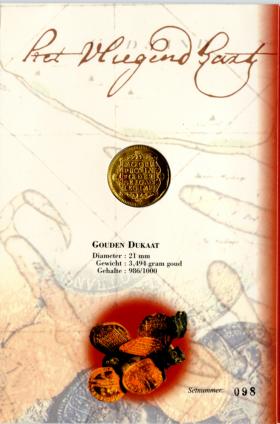|

On February 3, 1735, 't Vliegend Hart (The Flying Heart) left the Dutch port of Rammekens for Batavia in the East Indies. She carried a cargo of wood, building materials, iron, gunpowder and wine, as well as several chests filled with gold and silver coins. Shortly after leaving, the ship ran aground on the sandbanks of the Dutch coast. All cargo and crew were lost.
In the following days, barrels full of gin, beer and oil washed ashore on the beaches. In 1736, some items, including 700 wine bottles and an iron cannon were salvaged, but because of the harsh conditions, the wreck was eventually forgotten. Finally, in 1981, the site was rediscovered. Many artifacts, including wine bottles, bullets and an intact chest with 2,000 gold ducats and 5,000 Spanish silver reales were retrieved. In 1991 a second chest of gold ducats and Spanish reales was found, as well as several cases of silver ducatons. As these ducatons (riders) were not listed on the official cargo document it is likely they were smuggled on board by members of the crew to be sold for higher prices in the East Indies (source: Wikipedia).
The Royal Dutch Mint produced only 100 of these numbered sets in 1998. It has the Dutch guilder coins of that year in FDC quality, and one of those gold ducats recoverd from the ship, in a condition that can best be described as “as struck,” with full detail and lustre (the coin illustrated, dated 1729, is from the Westfrisia mint (Fr. 295).
First-come, first-served . |















